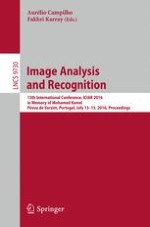This book constitutes the thoroughly refereed proceedings of the 13th International Conference on Image Analysis and Recognition, ICIAR 2016, held in Póvoa de Varzim, Portugal, in July 2016.
The 79 revised full papers and 10 short papers presented were carefully reviewed and selected from 167 submissions. The papers are organized in the following topical sections: Advances in Data Analytics and Pattern Recognition with Applications, Image Enhancement and Restoration, Image Quality Assessment, Image Segmentation, Pattern Analysis and Recognition, Feature Extraction, Detection and Recognition, Matching, Motion and Tracking, 3D Computer Vision, RGB-D Camera Applications, Visual Perception in Robotics, Biometrics, Biomedical Imaging, Brain Imaging, Cardiovascular Image Analysis, Image Analysis in Ophthalmology, Document Analysis, Applications, and Obituaries.
